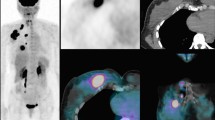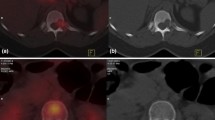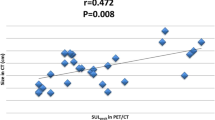Abstract
Purpose
The objective of this study was to assess the impact on management and the prognostic value of 18F-fluorodeoxyglucose (FDG) positron emission tomography (PET)/CT for initial staging of newly diagnosed large breast cancer (BC) when compared with conventional staging.
Methods
We prospectively included 142 patients with newly diagnosed BC and at least grade T2 tumour. All patients were evaluated with complete conventional imaging (CI) procedures (mammogram and/or breast ultrasound, bone scan, abdominal ultrasound and/or CT, X-rays and/or CT of the chest), followed by FDG PET/CT exploration, prior to treatment. The treatment plan based on CI staging was compared with that based on PET/CT findings. CI and PET/CT findings were confirmed by imaging and clinical follow-up and/or pathology when assessable. Progression-free survival (PFS) was analysed using the Cox proportional hazards regression model.
Results
According to CI staging, 79 patients (56 %) were stage II, 46 (32 %) stage III and 17 (12 %) stage IV (distant metastases). Of the patients, 30 (21 %) were upstaged by PET/CT, including 12 (8 %) from stage II or III to stage IV. On the other hand, 23 patients (16 %) were downstaged by PET/CT, including 4 (3 %) from stage IV to stage II or III. PET/CT had a high or medium impact on management planning for 18 patients (13 %). Median follow-up was 30 months (range 9–59 months); 37 patients (26 %) experienced recurrence or progression of disease during follow-up and 17 patients (12 %) died. The Cox model indicated that CI staging was significantly associated with PFS (p = 0.01), but PET/CT staging provided stronger prognostic stratification (p < 0.0001). Moreover, Cox regression multivariate analysis showed that only PET/CT staging remained associated with PFS (p < 0.0001).
Conclusion
FDG PET/CT provides staging information that more accurately stratifies prognostic risk in newly diagnosed large BC when compared with conventional explorations alone.





Similar content being viewed by others
References
Malvezzi M, Bertuccio P, Levi F, La Vecchia C, Negri E. European cancer mortality predictions for the year 2013. Ann Oncol 2013;24:792–800.
Verdecchia A, Francisci S, Brenner H, Gatta G, Micheli A, Mangone L, et al. Recent cancer survival in Europe: a 2000-02 period analysis of EUROCARE-4 data. Lancet Oncol 2007;8(9):784–96.
Sant M, Allemani C, Capocaccia R, Hakulinen T, Aareleid T, Coebergh JW, et al. Stage at diagnosis is a key explanation of differences in breast cancer survival across Europe. Int J Cancer 2003;106(3):416–22.
Aebi S, Davidson T, Gruber G, Cardoso F, ESMO Guidelines Working Group. Primary breast cancer: ESMO Clinical Practice Guidelines for diagnosis, treatment and follow-up. Ann Oncol 2011;22 Suppl 6:vi12–24.
Delbeke D. Oncological applications of FDG PET imaging. J Nucl Med 1999;40(10):1706–15.
NCCN clinical practice guidelines in oncology (NCCN guidelines): Breast cancer - version 3.2013. Available via National Comprehensive Cancer Network web site. http://www.nccn.org/professionals/physician_gls/pdf/breast.pdf. Accessed 17 May 2013.
Fuster D, Duch J, Paredes P, Velasco M, Muñoz M, Santamaría G, et al. Preoperative staging of large primary breast cancer with [18F]fluorodeoxyglucose positron emission tomography/computed tomography compared with conventional imaging procedures. J Clin Oncol 2008;26(29):4746–51.
Groheux D, Giacchetti S, Espié M, Vercellino L, Hamy AS, Delord M, et al. The yield of 18F-FDG PET/CT in patients with clinical stage IIA, IIB, or IIIA breast cancer: a prospective study. J Nucl Med 2011;52(10):1526–34.
Koolen BB, Vrancken Peeters MJ, Aukema TS, Vogel WV, Oldenburg HS, van der Hage JA, et al. 18F-FDG PET/CT as a staging procedure in primary stage II and III breast cancer: comparison with conventional imaging techniques. Breast Cancer Res Treat 2011;131(1):117–26.
Riegger C, Herrmann J, Nagarajah J, Hecktor J, Kuemmel S, Otterbach F, et al. Whole-body FDG PET/CT is more accurate than conventional imaging for staging primary breast cancer patients. Eur J Nucl Med Mol Imaging 2012;39(5):852–63.
Goldhirsch A, Wood WC, Coates AS, Gelber RD, Thürlimann B, Senn HJ. Strategies for subtypes–dealing with the diversity of breast cancer: highlights of the St. Gallen International Expert Consensus on the Primary Therapy of Early Breast Cancer 2011. Ann Oncol 2011;22(8):1736–47.
von Minckwitz G, Untch M, Blohmer JU, Costa SD, Eidtmann H, Fasching PA, et al. Definition and impact of pathologic complete response on prognosis after neoadjuvant chemotherapy in various intrinsic breast cancer subtypes. J Clin Oncol 2012;30(15):1796–804.
Greene FBC, Haller D, et al. Cancer staging manual. 6th ed. Philadelphia: American Joint Committee on Cancer (AJCC); 2002.
Groheux D, Moretti JL, Baillet G, Espie M, Giacchetti S, Hindie E, et al. Effect of (18)F-FDG PET/CT imaging in patients with clinical stage II and III breast cancer. Int J Radiat Oncol Biol Phys 2008;71(3):695–704.
Groheux D, Hindié E, Rubello D, Espié M, Baillet G, Giacchetti S, et al. Should FDG PET/CT be used for the initial staging of breast cancer? Eur J Nucl Med Mol Imaging 2009;36(10):1539–42.
Heusner TA, Kuemmel S, Umutlu L, Koeninger A, Freudenberg LS, Hauth EA, et al. Breast cancer staging in a single session: whole-body PET/CT mammography. J Nucl Med 2008;49(8):1215–22.
Uematsu T, Kasami M, Yuen S. Comparison of FDG PET and MRI for evaluating the tumor extent of breast cancer and the impact of FDG PET on the systemic staging and prognosis of patients who are candidates for breast-conserving therapy. Breast Cancer 2009;16(2):97–104.
Groheux D, Giacchetti S, Moretti JL, Porcher R, Espié M, Lehmann-Che J, et al. Correlation of high 18F-FDG uptake to clinical, pathological and biological prognostic factors in breast cancer. Eur J Nucl Med Mol Imaging 2011;38(3):426–35.
Koolen BB, Vrancken Peeters MJ, Wesseling J, Lips EH, Vogel WV, Aukema TS, et al. Association of primary tumour FDG uptake with clinical, histopathological and molecular characteristics in breast cancer patients scheduled for neoadjuvant chemotherapy. Eur J Nucl Med Mol Imaging 2012;39(12):1830–8.
Oshida M, Uno K, Suzuki M, Nagashima T, Hashimoto H, Yagata H, et al. Predicting the prognoses of breast carcinoma patients with positron emission tomography using 2-deoxy-2-fluoro[18F]-D-glucose. Cancer 1998;82(11):2227–34.
Cooper KL, Harnan S, Meng Y, Ward SE, Fitzgerald P, Papaioannou D, et al. Positron emission tomography (PET) for assessment of axillary lymph node status in early breast cancer: a systematic review and meta-analysis. Eur J Surg Oncol 2011;37(3):187–98.
Heusner TA, Kuemmel S, Hahn S, Koeninger A, Otterbach F, Hamami ME, et al. Diagnostic value of full-dose FDG PET/CT for axillary lymph node staging in breast cancer patients. Eur J Nucl Med Mol Imaging 2009;36(10):1543–50.
Pritchard KI, Julian JA, Holloway CM, McCready D, Gulenchyn KY, George R, et al. Prospective study of 2-[(18)F]fluorodeoxyglucose positron emission tomography in the assessment of regional nodal spread of disease in patients with breast cancer: an Ontario clinical oncology group study. J Clin Oncol 2012;30(12):1274–9.
Wahl RL, Siegel BA, Coleman RE, Gatsonis CG, PET Study Group. Prospective multicenter study of axillary nodal staging by positron emission tomography in breast cancer: a report of the staging breast cancer with PET Study Group. J Clin Oncol 2004;22(2):277–85.
Groheux D, Giacchetti S, Delord M, Hindié E, Vercellino L, Cuvier C, et al. 18F-FDG PET/CT in staging patients with locally advanced or inflammatory breast cancer: comparison to conventional staging. J Nucl Med 2013;54(1):5–11.
Costelloe CM, Rohren EM, Madewell JE, Hamaoka T, Theriault RL, Yu TK, et al. Imaging bone metastases in breast cancer: techniques and recommendations for diagnosis. Lancet Oncol 2009;10(6):606–14.
Shie P, Cardarelli R, Brandon D, Erdman W, Abdulrahim N. Meta-analysis: comparison of F-18 fluorodeoxyglucose-positron emission tomography and bone scintigraphy in the detection of bone metastases in patients with breast cancer. Clin Nucl Med 2008;33(2):97–101.
Alberini JL, Lerebours F, Wartski M, Fourme E, Le Stanc E, Gontier E, et al. 18F-fluorodeoxyglucose positron emission tomography/computed tomography (FDG-PET/CT) imaging in the staging and prognosis of inflammatory breast cancer. Cancer 2009;115(21):5038–47.
Bernsdorf M, Berthelsen AK, Wielenga VT, Kroman N, Teilum D, Binderup T, et al. Preoperative PET/CT in early-stage breast cancer. Ann Oncol 2012;23(9):2277–82.
Carkaci S, Macapinlac HA, Cristofanilli M, Mawlawi O, Rohren E, Gonzalez Angulo AM, et al. Retrospective study of 18F-FDG PET/CT in the diagnosis of inflammatory breast cancer: preliminary data. J Nucl Med 2009;50(2):231–8.
Cermik TF, Mavi A, Basu S, Alavi A. Impact of FDG PET on the preoperative staging of newly diagnosed breast cancer. Eur J Nucl Med Mol Imaging 2008;35(3):475–83.
van der Hoeven JJ, Krak NC, Hoekstra OS, Comans EF, Boom RP, van Geldere D, et al. 18F-2-fluoro-2-deoxy-d-glucose positron emission tomography in staging of locally advanced breast cancer. J Clin Oncol 2004;22(7):1253–9.
Groheux D, Hindié E, Delord M, Giacchetti S, Hamy AS, de Bazelaire C, et al. Prognostic impact of 18FDG-PET-CT findings in clinical stage III and IIB breast cancer. J Natl Cancer Inst 2012;104(24):1879–87.
Acknowledgments
This study is part of the Pharmimage project. The authors thank Paul M. Walker for his help in the revision of the manuscript.
Conflicts of interest
None.
Author information
Authors and Affiliations
Corresponding author
Rights and permissions
About this article
Cite this article
Cochet, A., Dygai-Cochet, I., Riedinger, JM. et al. 18F-FDG PET/CT provides powerful prognostic stratification in the primary staging of large breast cancer when compared with conventional explorations. Eur J Nucl Med Mol Imaging 41, 428–437 (2014). https://doi.org/10.1007/s00259-013-2595-4
Received:
Accepted:
Published:
Issue Date:
DOI: https://doi.org/10.1007/s00259-013-2595-4




